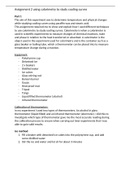Other
BTEC Applied Science unit 2, assignment 2, using calorimetry to study cooling curves
- Course
- Institution
This is part of the unit 2 assignment which is the physics part. I secured a merit in this piece of coursework as more detailed sentences were needed. Easy structure to follow
[Show more]



